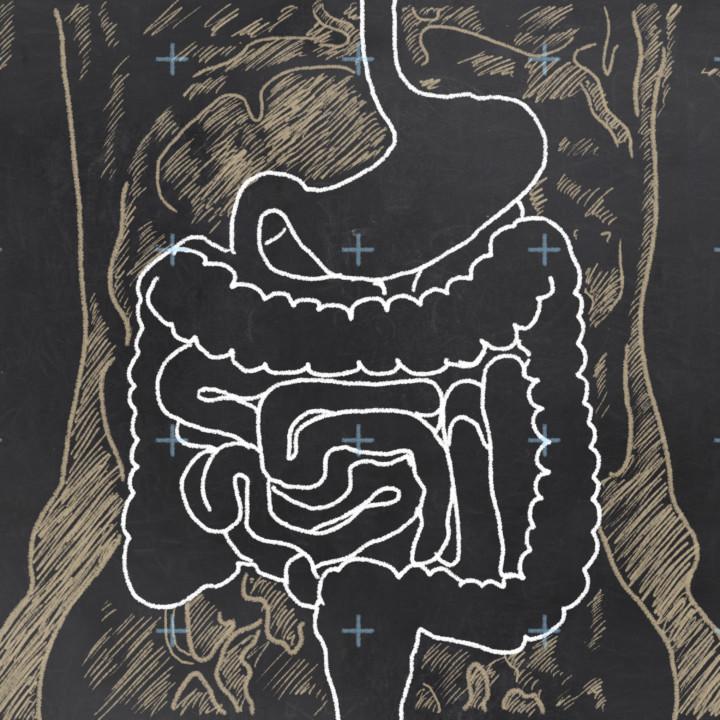Understanding the Microbiome
KEY TAKEAWAYS:
- The over 100 trillion microbes that constitute the body’s defense against disease can be negatively affected by the food we consume, such as processed foods and excess sugar.
- Microbes start to colonize us the moment we are born. Depending on how and where we were born, we’re colonized by different types.
- By the time a child is three years old, their microbiome resembles an adult’s and becomes more stable, though still influenced by sickness, antibiotics, stress, injury and diet.
- Of the several hundred species of bacteria that inhabit the gut, only a fraction has been identified, largely because most cannot be cultured, and identification is a challenge (Shanahan, 2002).
- Some of the carbohydrate/fiber we eat is resistant to digestion, but butyrate enhances healthy tissue turnover and maintenance, aiding with this issue. It’s unlikely that we eat enough resistant starch to be physiologically beneficial, making butyrate supplementation a prudent habit.
- A substantial volume of intestinal mucus depends on phosphatidylcholine (PC) for its structural integrity and function. PC accounts for more than seventy percent of its makeup.
The Microbiome and Bacteria
There are ten times more microbes in and on the body than there are cells in the body. A hundred trillion plus microbes (a debatable number) constitutes quite a fan club, which happens to do more than merely hang out – it fights disease, supports the immune system, detoxifies and even helps to maintain a trim waistline. But this all depends on housing the right microbes. Every neighborhood seems to have its rebel inhabitants. So too does the gut, where we can find hostile micro-organisms that initiate inflammation, play a role in obesity and instigate chronic disease.
It’s important to know that some foods interfere with the balance of microbes that occupy the body. Processed foods, products full of GMOs, sugar and heavily hybridized wheat and moldy grains may introduce irritants and pro-inflammatory characters that none of us needs. Instead of nourishing the body, they set us up for a host of chronic nightmares and they certainly fail to support the microbiome that nature fought so hard to provide and develop. Those tiny friends sitting on and about the body enhance immunity and that is the reason using anti-bacterial soaps and lotions is a bad idea. Plain, old-fashioned soap will sanitize your hand enough to be able to safely eat with them. By limiting exposure to a diversity of microbes, we’re making ourselves less capable of fighting sickness.
Playing in dirt is not a common adult pastime, but it does have benefits. Planting flowers, cutting grass and pulling weeds introduces us to micro-organisms that are on our side. Soil microbes are even recruited to manufacture natural medicines and supplements. Curious scientists noticed that billions of diverse microbes occupy just a teaspoon of soil, competing for nutritional support. It was a eureka moment in realizing that some of the triumphant compounds might combat human infections. Actinomycin, neomycin and streptomycin are but a few. And vancomycin is one of those used as a last resort against refractory bacterial infections. “-mycin” is the suffix for antibiotics produced from Streptomyces strains of bacteria. Whether any of the soil microbes enter the colonic biome makes little matter because all are members of a larger army designed to support human life.
The gut microbiome is populated by bacteria, archaea, fungi, protists and viruses. Bacteria and archaea are single-celled organisms that do not enclose their genetic material in a nucleus, making them prokaryotes, also known as monerans. Fungi and protists are eukaryotes, having a membrane-bound nucleus and organelles. Viruses are neither because they lack all the characteristics of living things. They reproduce, for example, only inside living cells where they hijack cytosolic materials to grow and to perform respiration. Every guest we host plays a role in life’s processes.
The Development of Bacteria Over a Lifetime
Microbes start to colonize us the moment we are born. Depending on how and where we were born, we’re colonized by different types. While still in the womb, we’re a hundred percent human. That changes after the journey through the birth canal and the first taste of mother’s milk. C-section babies are colonized mostly by skin microbes—a vastly different set of species (Dominguez-Bello, 2010). So different are they that the door to future health risks, such as diabetes, celiac disease and obesity, may have been opened (Neu, 2011). Babies acquire microbes from every person and thing they touch. Those born at home get a different collection from those born in a hospital. The vertical and horizontal transmission of bacteria to the neonate appears in feces in a few hours after parturition and reaches 108 – 1010 per gram of feces in a few days, at which point the mucosal immune response is shaped.
The microbial communities that reside in the gut and their impact on human health comprise one of the more intricate areas of research. A balanced intestinal community in early post-natal life is needed for the development of innate and adaptive immunity and the establishment of immune homeostasis later in life. Emerging evidence indicates that gut microbiota modulators, such as probiotics, prebiotics and synbiotics, may support disease prevention, particularly for caesarean and premature babies (Miniello, 2015). The first bacteria to inhabit the neonatal gut are usually aerobic or facultative anaerobic bacteria that include Enterobacteria, Enterococci and Staphylococci. As the microbiota complexity increases and more oxygen-sensitive species are established, the aerobic and facultative populations decline (Adlerberth, 2008). A range of factors influences the intestinal biota and its creation, including the mode of delivery and feeding, antibiotic exposure and contacts with parents, siblings and hospital personnel. From age ten days to four months, Staphylococci decline, while Bifidobacteria and Bacteroides peak (Øien, 2006) (Vebø, 2011) (Gueimonde, 2006).
Species compete for space and resources. Those best equipped to live in a specific environment will flourish, the dry oxygen-rich environs of the skin harboring a population different from the dark, watery environs of the mouth. More subtle variations in the environment can shape microbe populations as well, where buccal communities differ from those of the dorsal tongue.
The fecal bacteria of breast-fed infants are vastly different from those of formula-fed babies. The only similarity is that Streptococcus is the primary genus in both groups (Fan, 2013). The dynamic composition of human milk is exclusive in growth factors, cytokines, immunoglobins and digestive enzymes. Moreover, it’s associated with a lower incidence of necrotizing enterocolitis and diarrhea early in life, and in IBD, type 2 diabetes and obesity later in life (Le Huerou-Luron, 2010) (Øien, 2006). Where formula is fed, intestinal hypertrophy, intestinal permeability and bacterial translocation rise (Le Huerou-Luron, 2010). Where cow’s milk is fed, iron deficiency anemia may ensue from calcium/casein inhibition of non-heme iron absorption. Because the alien proteins increase the risk of allergy and induce a greater response to gastric inhibitory peptide and insulin, avoidance of cow’s milk during the first year is important (Alexander, 2003).
By the time a child is three years old, their microbiome resembles an adult’s and becomes more stable, though still influenced by sickness, antibiotics, stress, injury and diet. Of the several hundred species of bacteria that inhabit the gut, only a fraction has been identified, largely because most cannot be cultured, and identification is a challenge (Shanahan, 2002).
Diet and the Microbiome
Dietary habits may determine gut microbial composition, but the association of microbiota with different diets is yet to be completely understood. Comparing and contrasting diets of cultures from third-world and first-world countries, it can be seen that differences in gut microbes are substantial. Where Bacteroidetes flourish in the high-fiber diets of undeveloped societies, Firmicutes thrive in their counterparts. Studies conducted on mice found that obese animals have higher levels of Firmicutes than Bacteroidetes. In non-obese mice, the opposite is true. Transplanting the microbes from the obese group to the normal group resulted in weight gain among the normals, leading researchers to conclude that Firmicutes are better at extracting energy from food when contrasted to Bacteroidetes. This means that a strong Firmicute population will convert more food to energy, either to be used or to be stored as fat. Perhaps modulating the baseline microbiome population to include a higher percentage of Bacteroidetes by eating more fiber can induce weight loss (Kallus, 2012).
Some of the carbohydrate/fiber we eat is resistant to digestion. These resistant starches are fermented by specific gut bacteria to become substances known as short-chain fatty acids (SCFA’s), notably butyrates (Topping, 2001) (Wong, 2006). SCFA’s are the primary substrate for energy metabolism of colonocytes and they act as growth factors to the epithelium. Butyrate enhances healthy tissue turnover and maintenance*. It stimulates regeneration of the lining of the gut in diseased states and inhibits proliferation of neoplasms to impede potential tumor development*. Where faulty protein metabolism may eventuate to a buildup of ammonia, butyrate intercedes to sequester it and prevent neurotoxicity*. Generally, butyrate can alter gene expression by inhibiting an enzyme cascade known as HDAC, thereby modulating DNA replication and boosting wellness, especially in the pancreas, liver and brain (Davie, 2003)*. Where histone acetylation is dysregulated in conditions such as Alzheimer’s disease, butyrate has shown its capacity to treat memory impairment by mitigating amyloid pathology (Govindarajan, 2011)*. Should concerns about leaky gut/intestinal permeability abound, butyrate is able to close tight junctions and enhance the intestinal barrier (Peng, 2009)*.
Which Butyrate Should You Take?

Sodium Butyrate would be used by those who sweat profusely, such as marathoners, cyclists, people working in hot environments and those who exercise longer than an hour, as well as by persons with low blood sodium levels*.
Sodium Potassium Butyrate meets the needs of the same population, but accommodates those with sodium-sensitive hypertension, whereby potassium antagonizes and controls sodium*.
Calcium Magnesium Butyrate is the only butyrate supplement that is compounded to calcium-magnesium, instituted to meet the needs of an American populace terribly deficient in those minerals*.
It’s unlikely that we eat enough resistant starch to be physiologically beneficial, making butyrate supplementation a prudent habit.
How Does the Microbiome Protect Against Disease?
The body invests considerable effort in keeping the gastrointestinal tract protected against insults and invasions. The apical (top) surfaces of enterocytes are coated with glycosylated proteins commonly called mucus. In the small intestine there is a single layer; the stomach and colon have two. In the colon, the outer layer provides accommodation for commensal bacteria. The inner layer is impervious to bacteria and is renewed about every hour by what are called goblet cells, so called because they become distended with an accumulation of mucin granules that give them the appearance of a goblet. If bacteria ever reach this layer, an infection of some sort is suspected…or a really bad diet. A substantial volume of intestinal mucus depends on phosphatidylcholine (PC) for its structural integrity and function. PC accounts for more than seventy percent of its makeup. The exogenous administration of PC reinforces the mucus layer and is of therapeutic benefit in chronic intestinal disorders, such as ulcerative colitis (Diebel, 2014) (Olson, 2015). Mucus is made from a combination of several ingredients that work together to keep itself healthy, so it’s to our benefit to attend to its needs.

BodyBio PC provides a liposomal phospholipid complex that is well-known for its capacity to enhance central nervous function, to add surfactant to respiratory tissue, to augment cell membrane fluidity and permeability and to stabilize metabolic processes*. Also among its other multifarious characteristics, is improvement of gut function and homeostasis*.
For a long time, people have played with our food, adding colorants, preservatives, texturizers and whatever else it takes to keep it on the shelf, attractive and flavorful.
A few foods have achieved near perfection because of chemicals called emulsifiers, substances that help different things mix together when they normally would not. To their discredit, emulsifiers have shown themselves to alter gut microbiota and to incite an inflammatory response that promotes the development of disease and metabolic syndrome (Nguyen, 2015). Because it doesn’t hurt, we pay no attention to it, which is why being proactive with butyrate and phosphatidylcholine is vital. Before it does, to indicate that something could be wrong, it seems like a good idea to be proactive with butyrate and phosphatidylcholine.
Do Probiotics Help?
Probiotics? The most successful have documented clinical effects in large-scale consumption trials. Of these, L. acidophilus NFCB 1748, L. casei Shirota, L. GG (ATCC 53103) and L. acidophilus LA1 have durable reputations for efficacy. But there are others, as well (Holzapfel, 2001). To work as intended, probiotics need to adhere to the gut wall and to demonstrate high levels of colonization, meaning they need a nice place to live. Butyrate and PC provide that. However, we must beware of the use of medications that would wreak havoc within the microbiome — NSAIDS, oral contraceptives, corticosteroids and other pharmaceutical preparations. Antacids, H2 receptor antagonists and proton pump inhibitors threaten probiotics because they reduce stomach acid, allowing influx of pathogens that otherwise would be neutralized.
Because knowledge of the microbiome is not a settled issue, there is no conclusive maxim to which one may subscribe. Eating for the gut seems just as important as eating for the soul, as well as the body. As we strive to avoid physical and emotional conflict, so should we do for the gut’s sake, considering that one’s state of mind affects the biome on a bidirectional highway.








